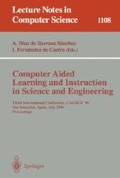Abstract
Today's information technologies support interactions at distance. Taking advantage of them, Télé-université has integrated collaborative learning activities into the learning set-up it proposes to learners. A typical learning environment provides learners with many information systems that help them to perform their tasks, to communicate with other people, and to manage their on-going learning processes. But collaborative learners still need resources capable to start again a stalled learning process. Furthermore group work within a class has to be managed: how many groups exists, who are the members of these groups, what is the state of the collaborative process... These models must follow closely the evolution of the groups. Such ever up-to-date models are very useful to help human and artificial tutors to balance the work load, to adjust their advising strategies, and to direct learners towards appropriate resources. In this paper, we address these issues related to collaborative learning by means of epiphyte advisor information systems. As the term epiphyte suggests, the advisor information systems are grafted onto existing arbitrary information systems. We show how to build distributed advisors; how they can take advantage of uptodate models to manage groups, and how they can use models of groups to produce advice for a collaborative learning process. These advisors rely on agents, organizations and hierarchical knowledge graphs. Hierarchical knowldege graphs help to design and structure descriptions of an advisor. At run-time, agents provide autonomy to the advisor's components, and organizations link and co-ordinate agents.
Preview
Unable to display preview. Download preview PDF.
References
Gasser, L., Social Conceptions of Knowledge and Action: DAI Foundations and Open Systems Semantics, Artificial Intelligence, 1991, vol. 47, no 1–3, pp. 107–138.
Giroux, S., Open Reflective Agents,in Intelligent Agents Volume II, M. Wooldridge, J.-P. Müller and M. Tambe, eds, Springer-Verlag, LNAI, 1996.
Giroux, S., A. Senteni and G. Lapalme, Adaptation in Open Systems, ICICIS, IEEE Computer Society Press, May 11–14, 1993, Rotterdam, Netherlands, pp. 114–123.
Giroux, S., F. Pachet and G. Paquette, Des systèmes d'information multi-agents épiphytes, Journées Francophones IAD et SMA, Voiron,France,May 9–11, 1994.
Giroux, S., F. Pachet and J. Desbiens, Debugging Multi-Agent Systems: a Distributed Approach to Events Collection and Analysis, Canadian Workshop on Distributed Artificial Intelligence, Banff, Canada, May 16,94.
Giroux, S., F. Pachet, G. Paquette and J. Girard, Des systèmes conseillers épiphytes, Revue d'intelligence artificielle, Afcet/Hermès, vol. 9, no 2, 1995, pp. 165–190.
Henri, F. Computer Conferencing and Content Analysis. In Kaye, A. (ed.) Collaborative Learning and Computer Conferencing. Pays-Bas, Springer-Verlag
Henri, F., Rigault, C. Collaborative Learning and Computer Conferencing. In Liao, T.T. (ed.) Advanced Educational Technology: Research Issues and Future Potential, Springer-Verlag, Berlin, 1994.
Leman, S., S. Giroux and P. Marcenac, A Generic Distributed Method for Cognitive Modelling, AI '94, 7th Australian Joint Conference on Artificial Intelligence, Nov. 94.
S. Leman, S. Giroux and P. Marcenac, A Multi-Agent Approach to ModellingStudent Reasoning Process, AI-ED 95, Aug. 16–19, 1995, Washington DC, USA, pp. 258–265.
Mertz, J.S. Jr, Using a simulated student for instructional design, AI-ED 95, August 16–19, 1995, Washington, USA, pp. 453–460.
Pachet, F. and S. Giroux, Building plan recognition systems on arbitrary applications: the spying technique, IJCAI-95 Workshop on The Next Generation of Plan Recognition Systems, August 20, 1995, Montréal, Canada.
Pachet, F., S. Giroux and G. Paquette, Pluggable Advisors as Epiphyte Systems, CALISCE '94. August 31, September 1–2, 1994, Paris, France, pp. 167–174.
F. Pachet, F. Wolinski and S. Giroux, Spying as an object-oriented programming paradigm, TOOLS Europe '95, Versailles, France, March 6–9, 1995, Prentice-Hall.
Pachet, F., J.-Y. Djamen, and C. Frasson, Production de conseils pertinents exploitant les relations de composition et de precedence dans un graphe de taches. Report DIRO #953, Université de Montréal, February 95.
Paquette, G., La modélisation par objets typés, Sciences et techniques éducatives, Hermès, to be published.
Paquette, G., F. Pachet and S. Giroux, ÉpiTalk, un outil générique pour la construction de systèmes conseillers, Sciences et Techniques Educatives, Hermès, vol. 1, no 3, 1994.
Paquette, G., et al., Design of a Knowledge-based Didactic and Generic Workbench, CALISCE'94, August 31, September 1–2 1994, Paris, France, pp. 303–311.
Paquette, G., F. Pachet, S. Giroux and J. Girard, EpiTalk, generating advisor agents for existing information systems, to appear in Journal of Artificial Intelligence in Education, Artificial Intelligence in Education Society, AACE, Charlottesville, USA.
G. Paquette, et al. Modeling a Virtual Campus Environment for Interactive Distance Learning, ED-Media, Graatz, Austria, June 95.
Ritter, S. and K. R. Koedinger, Towards lightweight tutoring agents, AI-ED 95, August 16–19, 1995, Washington DC, USA, pp. 91–98.
Smith, R.G., The Contract Net Protocol: High-Level Communication and Control in a Disptributed Problem Solver, IEEE Trans. on Computers, 1980, v.29, no12, 1104–13.
Author information
Authors and Affiliations
Editor information
Rights and permissions
Copyright information
© 1996 Springer-Verlag Berlin Heidelberg
About this paper
Cite this paper
Giroux, S., Paquette, G., Girard, J. (1996). Epiphyte advisor systems for collaborative learning. In: Díaz de Ilarraza Sánchez, A., Fernández de Castro, I. (eds) Computer Aided Learning and Instruction in Science and Engineering. CALISCE 1996. Lecture Notes in Computer Science, vol 1108. Springer, Berlin, Heidelberg. https://doi.org/10.1007/BFb0022590
Download citation
DOI: https://doi.org/10.1007/BFb0022590
Published:
Publisher Name: Springer, Berlin, Heidelberg
Print ISBN: 978-3-540-61491-3
Online ISBN: 978-3-540-68675-0
eBook Packages: Springer Book Archive

